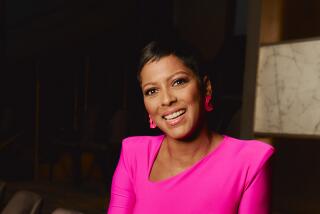All Things to All Women? : Television: Lifetime strives to corner the female market with series ranging from a Howard Stern-type show to home decorating.
- Share via
NEW YORK — Like two suburban homemakers on speed, Sissy Biggers and Susan Korn make jokes about breast pumps, thigh cream and sex after pregnancy on “Queens,” a 2-week-old talk show on the Lifetime cable-TV network.
The co-hosts ask TV sportscaster Andrea Joyce about the sights she has seen in an all-male locker room, and they earnestly share their fears about no-romance marriages with an anthropologist who urges busy couples to schedule sex and think of it as a treat, “like chocolate.”
“Queens,” intended as a female version of an outrageous, Howard Stern-style radio talk show, is one of a spate of new shows that Lifetime has introduced in the past few months in hopes of further establishing itself as the “women’s network.”
The new programming, which represents a $60-million investment by Lifetime, has a somewhat split identity, alternating between traditional women’s shows and feminism, between praise for women’s accomplishments and humor that strikes some observers as women putting themselves down.
“Women are 51% of the country--you can’t do one kind of programming for them,” explained Lifetime programming vice president Peggy Allen. “We have to reflect the diversity of women’s interests.”
*
Other recent additions to the network’s schedule range from “Lifetime Magazine,” a Wednesday night newsmagazine hosted by Lisa McRee of ABC News; to “Girls’ Night Out,” a Saturday night offering with only female comedians, to “Clapprood Live,” a talk show on Sundays at 11 p.m.
On Monday, Lifetime will introduce two more series that, by contrast, are right out of women’s magazines: “Our Home,” airing weekdays at 10 a.m. and 2 p.m., with host Marc Summers providing information about how viewers can “make the most of their homes without spending a fortune,” and “The Marriage Counselor,” airing weekdays at 11:30 a.m. and featuring a psychologist giving advice about issues that have been presented in dramatized form.
In an increasingly competitive TV environment, said Lifetime programming executive Judy Girard, “Original programming is what will ‘brand’ us in viewers’ and advertisers’ minds as the network that programs for and cares about women.”
Part of the difficulty of being the “women’s network,” however, is that women play many roles in life, and it may be more difficult to create a niche network for such a diverse group than for, say, children (Nickelodeon) or music-video lovers (MTV).
“I think that Lifetime is fishing around for an identity with its original programming,” observed Erica Gruen, senior vice president at the Saatchi & Saatchi advertising agency. “Having declared themselves the women’s network, they haven’t defined exactly what that means. Not that this is an easy thing to do; it’s probably easier to define a woman’s magazine for a particular audience--Good Housekeeping, Vogue or whatever--than it is to define an entire women’s TV network.”
*
Despite its success with cable operators and advertisers (the network had $150 million in gross advertising revenues in 1992, according to one cable-industry estimate) for its mix of female-appeal network reruns and a successful block of parenting programming, the 10-year-old Lifetime has not created a breakout hit, unlike Nickelodeon, MTV and even E! Entertainment Television with “Talk Soup.”
“Lifetime is trying a lot of new programming to see what works--and what will create some buzz about the network,” Gruen said.
Allen, who came to Lifetime from Hearst television, said that Lifetime is programming according to the profile of women who are available throughout the day.
“Our Home,” Allen said, will focus on women’s interests in home-decorating and cooking without assuming that they’re unsophisticated--or that they have all day to bake a cake. “We’re going to show women how to do the decorating they’ve seen in magazines. This is not going to be a show about making jewelry out of leftover cheese,” she said.
“Queens,” which airs weekdays at 1 p.m., and which Allen created, is “aimed at the intelligent young woman at home who turned off the TV set awhile ago because she couldn’t find anything she wanted to watch,” she said.
Allen acknowledged that “Queens” is probably the riskiest new venture, using two newcomers in a spontaneous format, but she disagreed with the notion that Biggers and Korn seem to be obsessing about sex and perceived imperfections in women. “Women talk about a variety of subjects, from politics to health care to orgasms, and I think we’re reflecting that,” she said.
Lifetime ranks No. 1 among basic-cable networks in total daytime viewing among 18-to-49-year-old women. But its ratings (currently averaging a meager 1 in prime time--representing 942,000 homes) dropped slightly over the past year, and USA, TBS and other cable networks also are going after female viewers with new programming.
“There certainly is competition for the women’s audience, but I think that Lifetime is the best place to reach the female audience,” said Douglas McCormick, who took over as president of Lifetime last year. “By experimenting with new and different programming, we will be more responsive to women’s interests--and we’ll stand out more on the cable dial.”
Lifetime’s owners, the Hearst Corp. and Capital Cities/ABC, recently paid $316.7 million to buy out their third partner, Viacom, which sold its interest to help pay for its purchase of Paramount.
“It’s an indication of what Hearst and ABC think of the potential of Lifetime that they paid that kind of money for it,” McCormick said.
More to Read
The complete guide to home viewing
Get Screen Gab for everything about the TV shows and streaming movies everyone’s talking about.
You may occasionally receive promotional content from the Los Angeles Times.






